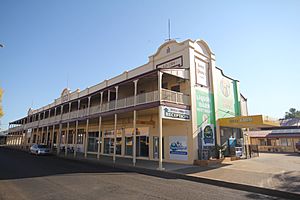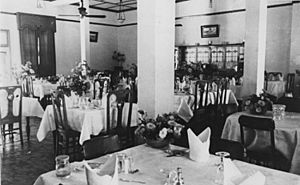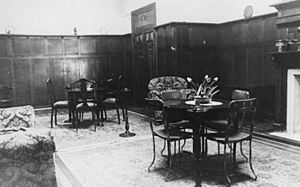Hotel Corones facts for kids
Quick facts for kids Hotel Corones, Charleville |
|
|---|---|

Hotel Corones, 2014
|
|
| Location | 33 Wills Street, Charleville, Shire of Murweh, Queensland, Australia |
| Design period | 1919 - 1930s (interwar period) |
| Built | 1924 - 1929 |
| Architect | William Hodgen junior |
| Official name: Hotel Corones, Charleville, Corones Hotel Norman | |
| Type | state heritage (built) |
| Designated | 1 July 1997 |
| Reference no. | 601282 |
| Significant period | 1920s (fabric) 1924-ongoing (historical, social use) |
| Significant components | hall, ballroom, lead light/s, furniture/fittings |
| Builders | Day labour |
| Lua error in Module:Location_map at line 420: attempt to index field 'wikibase' (a nil value). | |
The Hotel Corones is a famous old hotel in Charleville, Australia. It's listed on the Queensland Heritage Register, which means it's a very important historical building. The hotel was designed by William Hodgen junior and built between 1924 and 1929. It's also known as Corones Hotel Norman.
Contents
A Look Back at Charleville
Charleville was first mapped out in 1867. It's located on the Warrego River, which was a natural path for moving livestock. The town quickly became a major hub for the surrounding farming areas.
Bullock teams used to pass through Charleville. The famous coach company, Cobb and Co, even had stables there. They also built mail coaches and buggies in the town. In 1888, Charleville became a key transport spot when the Western railway line reached it. This railway later extended further west and south.
Charleville's Golden Age
The early 1920s were a time of great growth in Queensland. Charleville was a busy and rich town in western Queensland. It had nice hotels, shops, and offices for big farming companies. The town even got electric lights in 1924!
The airline Qantas started its first flights from Charleville in 1922. This was just after the last Cobb & Co coach ran in 1920. A new Town Hall was also finished in 1926.
However, a very bad drought hit in 1926. It caused huge losses for farmers. Many towns, including Charleville, then faced tough times during the worldwide economic depression of the 1930s.
The Story of Harry Corones
Harry Corones, often called "Poppa" Corones, was born on the Greek island of Kythera. He came to Australia in the early 1900s. By 1909, he was living in Charleville and working as a fruit seller.
In 1912, Harry became the owner of the Hotel Charleville. He ran this hotel until 1924.
Building a Dream Hotel
In 1926, Harry Corones bought the Hotel Norman. This was an older, single-storey hotel. He decided to build a grand new hotel on its site. This new hotel would be called Corones Hotel Norman at first.
Construction of the new hotel began in 1924. It was a huge project built in four stages. This allowed the old hotel to keep operating while the new one was being built. The dates "AD 1924" and "AD 1929" are still visible on the building. They show how long it took to finish.
Harry Corones wanted his new hotel to be strong and safe. Many timber buildings in town, including his old hotel, had been destroyed by fire. So, the Hotel Corones was built with strong materials. The first two parts were made of reinforced concrete, and the rest was brick.
The hotel cost about £50,000, which was a lot of money back then! Local workers were hired to build it. By the end of 1926, two-thirds of the new hotel was complete. The final part was finished in 1929.
A Grand Hotel for the West
The Hotel Corones became very famous. People said it was one of the best hotels outside the big cities. It was known as a place where important visitors and travelers would stay.
The hotel even had its own brochure! It showed off the beautiful interior. The lounge had shiny copper tables and comfy leather chairs. The dining room could seat 150 people. There was a special private bar and a modern public bar.
Upstairs, all the rooms opened onto a wide verandah. Some rooms even had their own bathrooms. The Corones Hall, located on Galatea Street, was perfect for big parties and dances. It could seat 320 people for dinner. The hall was designed to be cool, with high windows and electric fans.
All the furniture was made by F Tritton Ltd in Brisbane. They used beautiful Queensland wood, like Queensland maple. Even the carpets and curtains were from Britain.
The Architect's Masterpiece
The amazing architect behind the Hotel Corones was William Hodgen jnr. He was a very skilled architect from Toowoomba. He designed many different types of buildings, including other hotels in western towns.
The Hotel Corones is considered his most important work. It stands out in Charleville's main street. It shows a simpler, more modern style compared to his earlier designs.
A Hub of Activity
For over 30 years, the Hotel Corones was known as "The Leading Hotel of the West." It was popular with tourists, farmers, and traveling salespeople. Harry Corones proudly advertised that even royalty and important people stayed there.
Famous guests included pilot Amy Johnson and singer Gracie Fields. The Duke of Gloucester and Duchess also stayed at the hotel. In 1936, the hotel had about 133 guests every week!
During World War II, American soldiers stayed at the local air base. "Poppa" Corones' hotel was very busy then, with dances held almost every night in Corones Hall.
In 1959, Princess Alexandra visited Charleville. The town's welcome event for her was held right in front of the hotel. The hotel was still seen as the center of Charleville's social life.
Changing Times
However, new types of hotels, like motels, started to become popular. A severe drought in the 1960s also affected the local economy. The busiest days for the town and the hotel began to fade.
Harry Corones passed away in 1972. His son Peter and his wife Mary continued to run the hotel. Over the years, the hotel changed owners several times. In 1990, a motel was built behind the hotel. That same year, a big flood covered much of the town, and water entered the hotel's ground floor. After the flood, the hotel was repaired and some rooms were changed.
In 1993, the hotel was listed by the National Trust of Queensland. Today, the Hotel Corones is still a local pub and a popular tourist attraction. Daily tours are given, and Corones Hall is often used for weddings and balls. The story of Harry Corones and his grand hotel continues!
In February 2014, the hotel was sold to new owners who plan to add more dining and entertainment options.
What Does the Hotel Look Like?
The Corones Hotel is a two-storey building made of brick and concrete. It runs along Wills Street, which is Charleville's main street. It also has a single-storey ballroom and a hall that stretches along Galatea Street.
On the ground floor, you'll find the bar, main entrance, dining room, kitchen, and some shops. The first floor has guest rooms and a lounge area. There are also some newer motel units at the back, but these are not part of the historic listing.
Outside Features
The hotel has a wide, two-storey verandah that goes all the way along Wills Street and around the corner onto Galatea Street. It has a straight roof and is supported by timber posts. There's a simple timber fence, called a balustrade, on the first floor verandah.
Above the verandah, there's a tall decorative wall called a parapet. It has shaped sections at each end and in the middle. The name "HOTEL CORONES" is written in raised letters on the parapet. You can also see the building dates, "AD 1924" and "AD 1929", at each end of the building.
The main roof is made of corrugated iron. At the back, there's another verandah and a kitchen area with two large fireplaces.
The outside of the ground floor has doors for the main entrance and the bar. There are also deep casement windows, some with beautiful leadlight designs.
Next to the hotel, along Galatea Street, is the single-storey ballroom. It has a plain front with a simple roof. Beyond that is Corones Hall, which has a grand entrance with heavy wooden doors. The hall's front is decorated with brick patterns and the name "CORONES' HALL" in raised letters.
Inside the Hotel
The inside of the hotel still looks much like it did when it was built. The main entrance area, called the foyer, has beautiful silky oak wood panels. The ceilings are decorated with plaster, and there are lovely leadlight windows. The main staircase is also made of silky oak. Many of the original furnishings are still there, giving the hotel a classic feel.
Why Hotel Corones is Important
The Hotel Corones is listed on the Queensland Heritage Register for several reasons:
A Symbol of History
This hotel shows how Charleville and the surrounding farming areas grew and changed over time. Harry "Poppa" Corones built his hotel during a time of economic growth in the 1920s. It became famous for its hospitality. The hotel has seen both the good times and the tough times in the region.
A Unique Story
The hotel and Harry Corones became very well-known together. Using his own name for the hotel was unusual for the time. This helped both the man and the hotel become iconic in western Queensland. Harry Corones was a Greek immigrant, and his success in the hotel business on such a large scale was very rare. Most Greek immigrants in Queensland at that time ran smaller businesses like cafes. His story is a unique part of Queensland's history.
A Great Example of Design
The Hotel Corones is considered the most important work by architect William Hodgen jnr. It's a very noticeable building in Charleville. The hotel's inside areas, like the foyer, dining room, and even the bar, are still in great condition. Many original furnishings and fittings are also still there. This makes the Hotel Corones an excellent example of a grand hotel from the 1920s.
Beautiful and Strong
Many older buildings in Charleville were made of timber and were destroyed by fire. The Hotel Corones was one of several strong masonry (brick and concrete) buildings built in Charleville in the 1920s and 1930s. These buildings are important because they show a move towards using stronger, fire-resistant materials in the hot, dry climate of western Queensland. They also add to the town's unique look.



